Keeping Up the Tradition of Passalong Plants
Author: Jim George
I recently rediscovered a book on my bookshelf titled, Passalong Plants.
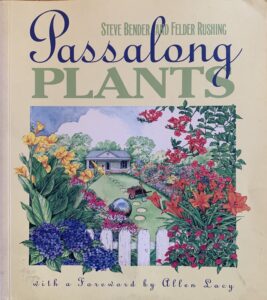
It was published 27 years ago by the North Carolina Press, and I think I must have bought it shortly thereafter. The book explains the Southern tradition of sharing plants among friends and neighbors, especially those plants hard to find in nurseries. The book describes a number of “old fashioned” plants in a very engaging and humorous style. They even have a humorous chapter devoted to southern yard art like bottle trees.
When I retrieved it from my bookshelf and thumbed through it, I realized what a different perspective I have now than back then. I found the book features some fine native plants, some of which I have in my own garden, and many exotic plants, some of which have become invasive in the years that have passed by.
After reading the book years ago, I’ve always liked the thought of keeping that tradition alive and both sharing and receiving plants this way. And true to the tradition, I’ve acquired and shared some wonderful passalong plants. In the modern context though, I would want the tradition to be retitled as “Passalong Native Plants”. So, I’m writing this article to encourage all of you to continue the tradition updated in a way so that you are restoring native habitat and, of course, not sharing exotic invasive species.
 River oats “meadow.”
River oats “meadow.” This discovery allowed me to reflect on a number of plants that I’ve received and given, and some that are not so easy to share. In the latter category, a friend of mine tried to dig up a sassafras tree seedling in the wooded area of my yard, only to discover that all the sassafras trees appeared to be interconnected by underground runners, even though at considerable distance from one another. She transplanted it but it did not survive.
You also need to be careful about giving away plants that “exuberantly” reseed like river oats. It’s a beautiful native grass and completely deer resistant, but if you’re not careful, it will soon take over your yard as it pops up everywhere. I’ve confined it now to an area of my yard that sometimes floods as storm drains overflow. All I had to do was spread some river oat seeds in that area and now I have a nice flood resistant meadow. So, in this case, you don’t even have to share the plants, just share the seeds!
Similarly, short-toothed mountain mint (Pycnanthemum muticum) is a vigorous spreader, but in this case by runners. My periodic pleas of come and take some are only occasionally answered by my more knowledgeable gardening friends since most of them probably already have all they could ever want. But it is a great pollinator plant and deer resistant to boot. It attracts a very wide range of species of pollinating wasps, bees, and even pollinator flies. There are many species of pollinators I’ve never seen before making me wonder where they come from and how they find the plant. And it can be kept under control by pulling it up around the edges after a rain.
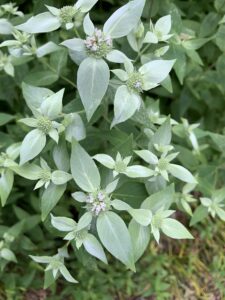 Mountain mint.
Mountain mint. One of the first native plants passed along to me from a neighbor was an American beautyberry bush seedling. It does spread from seed but in a more controlled manner. Each year you will have seedlings to give away or transplant where you want them. In a few years, you can have a beautyberry thicket as I’ve been able to create.
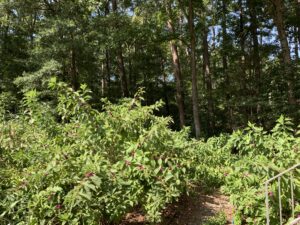 American beautyberry thicket.
American beautyberry thicket. Another plant that I’ve found easy to share is the Eastern aromatic aster, also deer resistant and a plant that puts on a great mid to late fall display. Once established, it will spread and seed in, and you’ll have plenty of seedlings to spare. You’ll also find it popping up in unwanted places, but as one friend put it, you will not be weeding it out but simply “editing.”
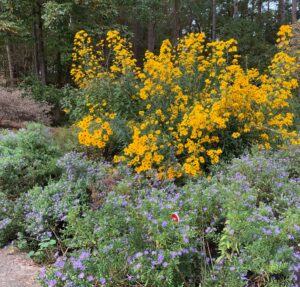 Aromatic asters and swamp sunflowers.
Aromatic asters and swamp sunflowers. Another vigorous spreader that will give you plenty of plants to share is the beautiful swamp sunflower. Despite its name, it seems to do well with just average moisture, perhaps needing a drink when it wilts during a drought. One vigorous stand I have was started from three seedlings given to me by a friend, and another stand has been given to me unintentionally by a next-door neighbor as it spread down across our property line. If it’s too tall for your garden or you want to keep it from flopping over, you can cut in back by half in early summer.
I could go on and on, but I think you get the idea. The original idea of passalong plants was to share old favorites that were not readily available in nurseries. Local nurseries are doing a much better job now in stocking native plants. This in part is due to increased public awareness of the value of native plant for birds, pollinators, and other wildlife. Also, Audubon NC and local chapters like our own New Hope Audubon have been encouraging garden shops to stock natives.
However, I encourage all of you to keep up the tradition. There is something special about receiving a favorite plant from a friend or neighbor and sharing yours in return. An additional bonus is that passalong plants have already been “field tested” in someone’s yard, and you can exchange valuable information on what conditions are needed for these plants to thrive.
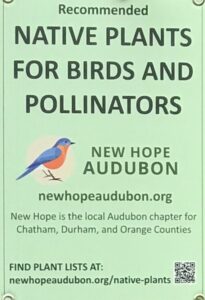 Our sign for garden centers selling native plants.
Our sign for garden centers selling native plants. “You don’t need a Ph.D., horticultural library, or yardman to belong to the Passalong Club. All that’s required is a piece of earth and a generous heart.” – Steve Bender and Felder Rushing, Passalong Plants.
All photos are by author and plant photos are from author’s yard.
« Back to All Press